If you’re looking to venture into pristine wilderness, you can find it in Big Bend.
Big Bend National Park, in Texas, is as beautiful as it is remote. The park is well worth the drive, but you should know what to expect and come prepared. Below you will find information about camping, hiking, what to expect, and things to do in Big Bend.
Camping in Big Bend
Chisos Basin Area
The Chisos Basin is an ideal place to set up camp, if you intend to explore all areas of the park. Here you will find the Chisos Basin Campground, as well as the Chisos Basin Lodge. Some campsites can be reserved in advance, but many are first come first served. The Chisos Basin Campground is centrally located. It is the starting point for many of the most spectacular hikes in the park. The elevation in this area is 5,400 feet, so be prepared temperature changes.
The one downside to camping here is the lack of showers. After a long day of exploring the park, you’re going to want to get cleaned up before getting cozy in your sleeping bag. On trips where I’m lacking a shower, I’ve found that Clean Trek Body Towels are a worthwhile addition to my bag. They come in packs of 12, and each is about the size of a washcloth. One towel is enough to get you smelling fresh again. The scent I use is called Mountain Moss, it smells like minty body wash.
You will not find a gas station in this area of the park. The closet fuel is located at Panther Junction, and the only other gas station is in the Rio Grande Village area.
Rio Grande Village Area
This is the preferred campground for RVers, it has the only full hook-ups in the park. Rio Grande Vilalge is effectively the Big Bend RV Park.
If skipping showers isn’t your kind of camping, there are coin operated showers in the Rio Grande Village Store. The showers are open 24 hours a day. These are the only showers available to campers in the park.. You can also take a dip in the Hot Springs adjacent to the Rio Grande, located in the same area of the park.
Rio Grande Village is located at 1,850 feet, near the Rio Grande River, so temperatures here will differ from what you find in the Chisos Mountains.
Big Bend river trips can depart from the boat launch in the Rio Grande Village.
If you’re interested in visiting Mexico, this campground is in proximity to the pedestrian border crossing.
Cottonwood Campground Area
Located near Castolon, not far from Santa Elena Canyon, the Cottonwood Campground offers some shade in an unlikely grove of trees.
If you are interested in canoeing or rafting the Rio Grande, Cottonwood is a convenient place to stay.
The elevation in this area is 2,169 feet. My wife and I stopped here to enjoy a picnic lunch in the shade.
Backcounty Camping in Big Bend
For those looking for a true wilderness experience, Big Bend has options for camping in undeveloped areas.
Permits for these site are issued on a first come first served basis.
Options for Backcountry Camping in Big Bend include:
- Primitive backpacking campsites along the trails
- Roadside camping in more remote areas of the park ( A high clearance vehicle is recommended for some sites.)
- Wilderness camping (Includes areas with no designated campsites.)
All of these options require a permit, issued up to 24 hours in advance, at one of the visitor centers.
If you are new to camping, consider bringing an experienced travel companion if you plan on wilderness camping.
Hotels and Cabins in Big Bend National Park
If you’re looking for a hotel in Big Bend, look no further than the Chisos Mountain Lodge. The lodge is your only hotel option when staying within the park. As I mentioned before, the Chisos Basin is an ideal base camp for exploring all areas of Big Bend. The lodge offers rooms with showers, a restaurant, a visitors center and a store with basic supplies. The food at the restaurant isn’t the greatest, think cafeteria food, in a sit down setting, with a nice view of the Chisos Mountains.
Hotel and camping options worth visiting on the way to Big Bend:
- The Gauge Hotel in Marathon, TX
- El Cosmico in Marfa, TX
- Balmorhea State Park in Toyahvale, TX
When to Visit Big Bend
The desert flowers bloom sometime between March and April. The other popular time to visit is from October-November.
Summertime can be very hot, making it physically impossible to carry enough water for some of the longer hikes in the park. There are usually fewer visitors in the park during this time.
Big Bend National Park Temperature
Temperatures in the park can vary as much as twenty degrees based on elevation. This is compounded by dramatic temperature shifts from day to night.
In the winter, be prepared for anything from 80 degrees to below freezing. Summer travelers should avoid activity at midday, especially in the low desert areas where temperatures can easily rise above 100 degrees fahrenheit.
Rain can bring flash flooding in some areas, so be aware of weather conditions and your surroundings.
Fuel and Supplies Within the Park
Within the park your options for fuel and supplies are limited:
- Panther Junction (Fuel, Basic Supplies and ATM)
- Rio Grande Village (Fuel, Basic Supplies and ATM)
- Chisos Basin Store (Basic Supplies, ATM)
- Castolon (Basic Supplies)
I recommend stopping for supplies before you reach Big Bend. It is also a good idea to carry cash, as credit card machines are frequently down in the small towns on the way to Big Bend.
Marathon has a small grocery store called French Grocer. If you stop in Marathon, the historic Gauge Hotel is worth a visit. My wife and I have stopped in Marathon to explore, and eat lunch in the bed of my truck.
Visiting Mexico
If you bring your passport, you should consider visiting Mexico for lunch.
The Boquillas border crossing is open Wednesday through Sunday from 8-5 in the winter and 9-6 in the summer.
Park at the crossing and walk down to the Rio Grande. You will be greeted by villagers who will ferry you across the river ($5.00 US round trip).
Form there you can walk approximately a mile to the village of Boquillas. For another $5.00 you can ride a donkey into town.
In town, you can browse crafts made by locals or eat at one of the two restaurants. Jose Falcon’s has the best views. The margaritas and enchiladas at Boquillas Restaurant are delicious. Both establishments accept US dollars.
Make sure you get back before the border crossing closes, or you will be spending the night in Mexico.
Getting to Big Bend
Big Bend National Park is located 204 miles south of Midland, TX. If you would like to fly, MAF is the closest airport. From there, it is about a three hour drive to the closest park entrance.
How Long is the Drive to Big Bend From:
- Albuquerque, NM: 8.5 hours to drive 517 miles
- Austin, TX: 7 hours to drive 437 miles
- Dallas, TX: 8 .5 hours to drive 533 miles
- Houston, TX: 8.75 hours to drive 563 miles
- Lubbock, TX: 5 hours to drive 321 miles
- Midland, TX 3.25 hours to drive 204 miles
- Oklahoma City, OK: 9.5 hours to drive 619 miles
- San Antonio, TX: 6 hours to drive 412 miles
- Tucson, AZ: 9 hours to drive 609 miles
Big Bend National Park Maps
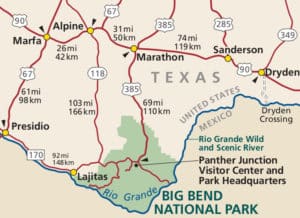
Map of Big Bend Region
Big Bend Ranch State Park
If you’ve visited Big Bend in the past and want to explore a new area, take a look at Big Band Ranch State Park. Though in close proximity to the national park, the journey to Big Bend Ranch state park will take you a couple of hours. The route between the parks is a little long and indirect, if you’re driving in from the west it will take you roughly the same amount of time to reach the state park as it does the national park.
Wildlife in Big Bend National Park
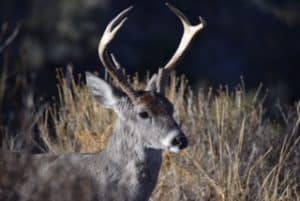
A buck seen on the Window Trail
Birds
If you are into bird watching, you are going to love Big Bend. There are more than 450 species living within the park, so of which are found only in this area. The roadrunner is common, and probably my favorite.
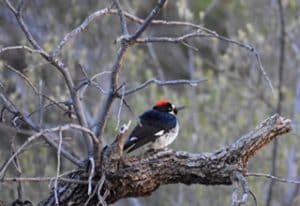
Acorn Woodpecker in Big Bend National Park
Black Bear
I was surprised when I learned that black bears could be found anywhere in Texas. Almost non-existent before Big Bend became a park, the bear population has recovered. It is not uncommon to see bears in the park. Take the usual precautions, secure food, make noise on the trail and try not to hike alone. Use common sense, and you are unlikely to be bothered by a bear.
Deer
The Carmen Mountains Whitetail lives in the mortician areas of the park. This subspecies is one of the smallest in the country. I’ve seen them while hiking Window Trail in the Chisos Basin.
Mule Deer can be found in the desert areas near panther junction.
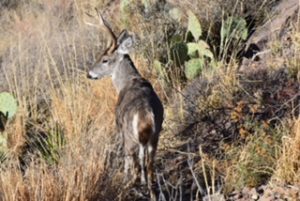
A buck seen on the Window Trail
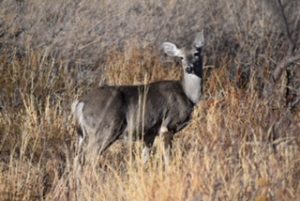
A Doe spotted on the Window Trail
Fox
When stargazing in the Chisos Basin, a fox visited me a couple nights in a row. He was stealthy and startled me every time. Though unsuccessful, I enjoyed trying to get a photo of him.
Javelina
I’m always on the lookout for this pig like creature. Common in the southwest, we don’t see Javelina often around Dallas. They blend in pretty well with the brush, you are most likely to spot one along the road.
Mountain Lion
Mountain lion sightings are rare. Between all the visitors to the park each year, only 150 sightings are reported on average. I have yet to see one in the park, but it doesn’t stop me from searching areas where I can imagine them hiding. Grassy areas in the park would provide perfect concealment for a monument lion. I would love to photograph a mountain lion some day. In the unlikely event you encounter a mountain lion on the trail, make noise, swing your arms and try to look as big as possible. Much like black bears, they will usually run from humans. Predators don’t like to risk injury that could prevent them from hunting, and will opt for an easy meal when possible.
Snakes
While said to be common, the rattlesnake is another animal I search for and have yet to find in the wild. While many snakes in the park are nonvenomous, it is home to four species of venomous rattlesnake and the copperhead as well. Stay on the trail and be mindful of where you sit and put your hands.
What to Pack for a Camping Trip to Big Bend
Wearing layers is a good idea no matter where in the park you visit. Temperatures change dramatically from day to night, and also by elevation.
Big Bend Packing List
- Water (1 Gallon a Day Per Person)
- Wide Brimmed Hat
- Sunscreen
- Sunglasses
- Long Sleeve SPF Shirt/Pants
- Warm Layers
- Food
- Tent
- Camp Stove
- Lighter for Stove
- Passport
- Headlamp
- A sleeping bag rated 10 degrees colder than you expect the expected low temperature.
- Camera
- Cash (It is not unusual for credit card machines to be down in the small towns between Midland and Big Bend. Cash is also useful when visiting Mexico.)
Top Hikes in Big Bend:
Window Trail (5.5 mile out and back)
I really enjoy this hike. It is a good one to do in the morning when staying in the Chisos Basin. There is a good chance you will see some deer in the morning and evening. This would be a good hike for birders as well. The hike leads to the top of what is essentially dry waterfall with a magnificent view. Flash flooding is possible in this area, so avoid it in if rain is in the forecast.

View from Window Trail
Chisos Loop (16.6 mile loop)
The views from Emory Peak and the canyon rim are some of the most spectacular in the park.
This popular hike is strenuous and often broken up into more than one day.
Remember, you will need around a gallon of water per person per day when hiking in Big Bend. Some hikers cache water along the route to lighten their load.
Lost Mine Trail (4.8 mile out and back)
If you are new to hiking, or don’t have much time in the park, the Lost Mine Trail offers a moderate challenge and excellent views of Big Bend. This hike will give you a good idea of what Big Bend has to offer.
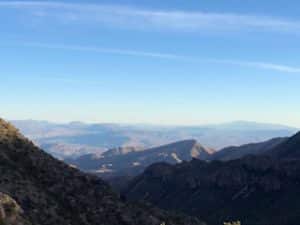
View from Lost Mine Trail in Big Bend National Park
Santa Elana Canyon (.8 mile out and back)
This is an easy hike, once you get past a short stair climb, into Santa Elana Canyon. Though short, this is another one of my favorites. The canyon is beautiful, one side is in the US and the other side is in Mexico. I’ll go as far as describing this one is magical.
Tuff Canyon (.75 miles)
Tuff Canyon is more of a place to explore than a hike. The canyon is cut into rock formed by volcanic ash. The hike leads into a dry canyon bottom. This is a great hike to teach kids about earth science, or just examine the various layers of rock. Tuff canyon is just down the road from Santa Elena Canyon. Its a nice stop on the way back to the Chisos Basin.
Fossil Discovery Exhibit at Big Bend National Park
This self guided fossil exhibit is open during daylight hours. The exhibit is open air, so there is no need to worry that it will close before you arrive. The fossil exhibit is a great way to learn about the history of the area and to view examples of fossils discovered within the park.
Things to Do in Big Bend
- Stargazing
- Sing a song in Santa Elena Canyon (It echoes like a cathedral)
- Relax in the Hot Springs
- Take the Ross Maxwell Scenic Drive to see various geologic features
- Horse and Donkey Rides (To the village of Boquillas in Mexico)
- Explore Tuff Canyon (It was carved out of volcanic ash)
- Watch the Sunset over the Chisos Mountains
- Visit the Ghost Town of Terlingua
- Practice Wildlife Photography
- Bird Watching
- Kayaking and Canoeing
- Hiking
- Camping
It’s Time to Visit Big Bend
Hopefully, you are feeling confident, and ready to venture into the wilderness known as Big Bend National Park.
This park is remote, lacking infrastructure common to more popular national parks.
Some roads are primitive, and should not be attempted without a high clearance vehicle. Read maps and signs carefully. Bring plenty of water.
The isolation of Big Bend is part of its charm. It is easy to imagine what an experience in the early days of the park system would have been like. With a little preparation, your visit to Big Bend is going to be memorable. Big Bend may just become one of your favorite places on planet earth.
Happy Trails.
Bad weather have you stuck indoors? Try this list of Outdoor Adventure Books to Read on Rainy Days.
